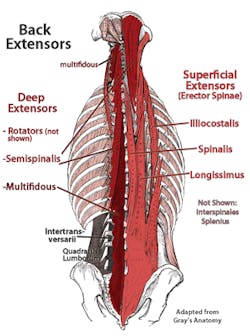It’s 6 calls into the shift and the call volume has not let up, it’s going to be a long shift. Your vest feels particularly tight and restrictive today and your belt is cutting into your hip. There has been talk about transitioning over to tactical vests but you are on the fence. While it would be nice to have less gear on your waist, as you shift a little in your seat, giving an assailant anything else to grab does not seem a good idea.
As you mull this thought over you shift even more in your seat to move around your gear and now your left lower back is hurting again. Maybe having less gear on your hips is not such a bad idea after all, especially if that old low back injury comes back.
As a society we are taught to ignore pain and this is exactly what we have to stop doing. Pain, especially aching, nagging pain is a warning or a symptom of bigger things to come. Just like the check engine light it’s a warning that must be heeded. Those little spasms, aches and pains are what often become the bigger injury and herein lies what you know wrong about back pain.
1. Your back is not strong
Your back is not strong; the notion of a strong back is a myth. The spine has some pretty specific jobs including protecting the spinal cord and as an attachment point for muscles and this is where we need to have a better understanding.
Think of your spine as a stack of ovalish blocks. In between each block is a jelly doughnut. On top of the block stack is a bowling ball; which is too far forward (forward head posture). The stack of blocks also sits on this ‘funky’ base called your pelvis. This pelvis can move in all kinds of crazy directions and often leans too far forward as well.
If we think of the spine this way then there is no possibility that something like this can have any “strength.” Your back ‘strength’ comes from a combination of hip strength, abdominal co-contraction to help stiffen the spine and from a strong “extensor chain.”
The extensor chain includes the upper, middle and lower trapezius, cervical-thoracic-lumbar paraspinals, glutes and hamstrings.
Simply put to have a “strong” back you must have very strong glutes (think dead lifts-squats-step up’s), strong anterior and lateral abdominals to stiffen the torso when under load and strong well balanced spinal extensors.
2. Posture matters
Where does your back hurt most of the time? usually it’s in the para-spinal muscles from T8-L2 (where your middle back and lower back meet. Grab a tennis ball or stick your fist back there, just to the side of your spine and feel how sore and nasty those muscles are.
Every time you lift/move/drive/sit/run with your head down, back round or knees locked the strain goes to this area. Over time the tissue fatigues, repetitive motion disorder, and eventually injury will occur. As this tissue is getting broken down from poor technique and poor posture those injurious loads are also being transferred into the jelly doughnuts.
*If you take 10 people randomly off the street and do an MRI of their back roughly 4 will have disk bulges with no symptoms and 2-3 more will have microfractures in their disks. Responders every lift counts, any lift or exercise can hurt you because the damage has already been done, we are just not symptomatic yet!
3. BMI effects movement and can cause injury
A 1999 study published in the American journal of public health concluded that “High job strain was the most important factor affecting back injury. Body mass index and a work movement index (twisting, extended reaching, and stooping) were also significant factors in injury”.
As first responders we have both. High job strain from lifting, moving, fighting, running etc. -CHECK. Are a majority of responders overweight and or sedentary with correspondingly high BMI’s-CHECK. Law Enforcement is a physical job and to safely perform the job you have to have the strength and mobility to do the job.
A high BMI is also associated with specific postures that alter how you move. Upper cross and lower cross patterns are significantly worse with a high BMI. The anterior pelvic rotation, foot position changes, forward head and rounded shoulders all change how your biomechanics and will set you up for everything we discussed already.
Every time I teach a class someone has to boast that they have no pain or have not had an injury. While this is great the goal is to stay injury free, do not ignore good mechanics and good tissue conditioning just because you do not have pain yet. Remember almost all responders are well down the path of injury. Repetitive injury occurs for years, the tissue often compensates for a long time before the injury occurs. Keep your tissue loose, stretch every day and use your foam roller. Use awesome ergonomics every time, every lift counts. Exercise every day, even if it’s just 10 minutes of walking 3-4 times a day, move!
*Final Tip: Never sit on your wallet or anything high enough to shift your hips. Sitting on your wallet is causing your back pain by shifting your hips.

Bryan Fass
is a leading expert on public safety injury prevention. As the president and founder of Fit Responder Bryan’s company works nationally with departments, corporations; state and local governments to design and run targeted injury prevention and wellness programs. He is frequently contacted for expert opinion and content contribution for all aspects of public safety fitness, ergonomics and wellness. Bryan authored the Fit Responder book used by departments and schools plus writes for numerous web and peer-reviewed journals including the NSCA-Tactical Strength & Conditioning journal, officer.com, ems-1.com & best practices in EMS. Bryan holds a bachelors’ degree in sports medicine with over 17 years of clinical practice, was a paramedic for over 8 years, and is certified as an Athletic Trainer (ATC, LAT), Strength Coach (CSCS) and the Functional Movement Screen (FMS). Fit Responder developed the nation’s first validated pre-hire Physical Abilities Test for EMS. Bryan is a sought-after speaker on a variety of topics including risk reduction, employee self-care, real world wellness and How to Eat on the street. www.fitresponder.com
Every Lift Counts!



